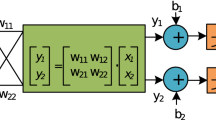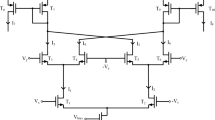Abstract
This paper first establishes a neural network model for logic circuits from the truth table by using linear equations theory, presents a kind of ATPG neural network model, and investigates energy local minima for the network. And then, it proposes the corresponding techniques to reduce the number of energy local minima as well as some approaches to escaping from local minimum of energy. Finally, two simulation systems, the binary ATPG neural network and the continuous ATPG neural network, are implemented on SUN 3/260 workstation in C language. The experimental results and their analysis and discussion are given. The preliminary experimental results show that this method is feasible and promising.
Similar content being viewed by others
References
Agrawal V D, Seth S C. Test Generation for VLSI Chips. IEEE Computer Press, Washington D.C., 1988.
Yau S S, Tang Y S. An efficient algorithm for generating complete test sets for combinational logic circuits.IEEE Trans. on Computers, 1971, C-20: 1245–1251.
Roth J P, Bouricious W G. Programmed algorithms to computer tests to detect and distinguish between failures in logic circuits.IEEE Trans. Election. Computers, 1967, EC-16(10): 567–580.
Goel P. An implicit enumeration algorithm to generate tests for combinational logic circuits.IEEE Trans. on Computers, 1981, C-30(3): 215–222.
Fujiwara H, Snimono T. On the acceleration of test generation algorithms.IEEE Trans. on Computers, 1983, C-32(12): 1137–1144.
Khanna T. Foundations of Neural Networks. Addison-Wesley Publishing Company, Inc., 1990.
Abu-Mostafa Y S. Neural Networks for Computing? Neural Networks for Computing (Snow-bird). Denker J S (ed.), American Institute of Physics, New York, 1986, pp. 1–6.
Chakradhar S T, Bushnell M L, Agrawal V D. Toward massively parallel automatic test generation.IEEE Trans. on CAD, 1990, 9(9): 981–994.
Chakradhar S T, Bushnell M L, Agrawal V D. Neural net and Boolean satisfiability models of logic circuits.IEEE Design and Test of Computers, 1990, 7(5): 54–57.
Chakradhar S T, Bushnell M L, Agrawal V D. Automatic test generation using neural networks. InProc. Int. Conf. on CAD, pp. 416–419, Nov. 1988.
Fujiwara H. Three-valued neural networks for test generation. InProc. 20-th Fault-Tolerant Computing Symposium, pp. 64–71, 1990.
Chakradhar S T, Bushnell M L, Agrawal V D. Automatic test generation using quadratic 0–1 programming. InProc. 27-th ACM/IEEE Design Automation Conference, pp. 654–659, 1990.
Zhang Zhong. New Testing Methods for Digital Circuits and Their Simulation Experiments. Ph.D. Dissertation, Institute of Computing Technology, The Chinese Academy of Sciences, 1991.
Zhang Zhong and Wei Daozheng. Neural network model for logic circuits.Acta Electronica Sinica, 1993, 21(8): 77–81. (in Chinese).
Zhang Zhong. Modelling the neural network for logic circuits by linear equations theory. InProc. 9th National Conference on Pattern Recognition and Artificial Intelligence, pp. 331–339, 1993. (in Chinese)
Zhang Zhong, Dai Ruwei. Necessary and sufficient condition for the existence of neural network model of logic circuits. InProc. of World Congress on Neural Networks, San Diego, U.S.A., Vol.II, pp.491–497, 1994.
Hopfield J J. Neural networks and physical systems with emergent collective computational abilities. InProc. of Natl. Acad. Sci. USA, Vol.79, pp.2554–2558, 1982.
Hopfield J J. Neurons with graded response have collective computational properties like those of two-State neurons. InProc. of Natl. Acad. Sci. USA, Vol. 81, pp.3088–3092, 1984.
Hopfield J J. Neural computation of decisions in optimization problems.Biological Cybernetics, Vol. 52, pp.141–152, 1985.
Hopfield J J. Artificial neural networks.IEEE Circuits and Devices Magazine, 1987, 4(5): 3–10.
Takeda M, Goodman J W. Neural ntworks for cmputation: Number representations and programming complexity.Applied Optics, 1986, 25(18): 3033–3046.
Author information
Authors and Affiliations
Additional information
Supported in part by National Natural Science Foundation of China.
Zhang Zhong received his M.S. degree in electronics from the University of Electronic Science and Technology of China in 1988 and his Ph.D. degree in computer science from the Institute of Computing Technology, the Chinese Academy of Sciences in 1991. He is currently an Associate Professor of Computer Science in the National Research Center for Intelligent Computing Systems (NCIC), the Chinese Academy of Sciences. His research interests include neural networks, evolutionary computation and its applications, genetic algorithms, nonlinear dynamical systems, parallel and distributed computing, artificial intelligence, pattern recognition and so on.
Rights and permissions
About this article
Cite this article
Zhang, Z. Simulation of ATPG neural network and its experimental results. J. of Comput. Sci. & Technol. 10, 310–324 (1995). https://doi.org/10.1007/BF02943500
Received:
Revised:
Issue Date:
DOI: https://doi.org/10.1007/BF02943500




